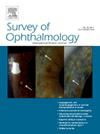微导管辅助微创青光眼手术治疗开角型青光眼的疗效及并发症:系统综述和网络荟萃分析。
IF 5.9
2区 医学
Q1 OPHTHALMOLOGY
引用次数: 0
摘要
微导管辅助微创青光眼手术(MIGS)越来越多地被用作小梁切除术联合丝裂霉素C (MMC Trab)控制开角型青光眼(OAG)眼压(IOP)的替代方法,但目前还没有比较不同微导管辅助微创青光眼手术和MMC Trab的头对头试验。我们通过网络meta分析(NMA)评估了微导管辅助的MIGS手术的相对有效性和安全性,包括微导管辅助小梁切开术(MAT)、gonioscopy辅助腔内小梁切开术(GATT)、ab-间管成形术(ABiC)、ab-外管成形术(ABeC)和小梁隧道成形术(3T),重点是它们在降低IOP和药物使用方面的优先级排名。MMC Trab被纳入作为参考标准,以确定新兴微导管辅助技术的性能。我们检索了2009年1月1日至2024年10月16日之间发表的研究,没有受试者年龄或发表语言的限制。审查遵循在PROSPERO (CRD42024557637)上注册的方案进行。报告遵循PRISMA准则。对于观察性研究和随机对照试验,分别使用纽卡斯尔-渥太华质量评估量表(NOS)和Cochrane随机试验偏倚风险评估工具(RoB 2)进行评估。数据提取由2名独立审稿人进行,然后由第三名审稿人进行检查和裁决。估计连续变量的平均差异、二元变量的风险比、95%可信区间(CI)和干预措施的等级。检查的结果包括IOP降低(%)和3个月和1年的基线用药减少。我们还提取了报道的不良事件,如前房积血、眼压升高和低眼压。16项研究(共1081只眼睛)被纳入NMA。1年疗效方面,MAT与MMC Trab相比,IOP降低百分比(MD -4.78% (95%CI -3.01%至3.45%),SUCRA 65.7)和用药减少(MD 0.18 (95%CI -0.19至0.54%),SUCRA 97.4), GATT (MD -7.20% (95%CI -13.73%至-0.67%),SUCRA 53.1%)与MMC Trab在用药减少方面无显著差异。对于术后3个月内的并发症,所有微导管辅助的MIGS手术与MMC Trab手术在术后IOP尖峰方面没有显著差异。与MMC Trab相比,GATT (RR 0.06 (95%CI, 0.01 ~ 0.35), SUCRA 87%)和ABeC (RR 0.3 (95%CI, 0.1 ~ 2.92), SUCRA 44.3%)与低睡眠风险相关。所有微导管辅助的MIGS手术都与前房积血的高风险相关。与MMC Trab相比,MAT在术后1年的疗效无显著差异,并且某些微导管辅助的MIGS手术在术后并发症方面比MMC Trab具有特定的优势。本文章由计算机程序翻译,如有差异,请以英文原文为准。
Efficacy and complications of microcatheter-assisted minimally invasive glaucoma surgery for open-angle glaucoma: A systematic review and network meta-analysis
Microcatheter-assisted minimally invasive glaucoma surgery (MIGS) procedures are increasingly being used as an alternative to trabeculectomy combined with mitomycin C (MMC Trab) for controlling intraocular pressure (IOP) in open-angle glaucoma (OAG), but there are no head-to-head trials comparing different microcatheter-assisted MIGS procedures and MMC Trab.
We evaluate the relative efficacy and safety of microcatheter-assisted MIGS procedures, including microcatheter-assisted trabeculotomy (MAT), gonioscopy-assisted transluminal trabeculotomy (GATT), Ab-interno Canaloplasty(ABiC), ab externo canaloplasty(ABeC), and trabeculotome tunnelling trabeculoplasty surgery (3 T), through a network meta-analysis with a focus on their priority ranking in IOP reduction and medication use. MMC Trab was included as the reference standard to contextualize the performance of emerging microcatheter-assisted techniques.
We conducted searches for studies published between 01/01/2009 and 16/10/2024, with no restrictions regarding participant age or language of publication.
We followed a protocol registered on PROSPERO (CRD42024557637). PRISMA guidelines were followed for reporting. For observational studies and randomized clinical trials, use the Newcastle-Ottawa Quality Assessment Scale and Cochrane Risk of Bias tool for Randomized Trials (RoB 2) respectively for evaluation. Data extraction was conducted by 2 independent reviewers, and then checked and adjudicated by a third reviewer. The mean differences for continuous variables, risk ratios for binary variables, 95 % credible intervals, and ranks of interventions were estimated.
The outcomes examined included the reduction (%) in IOP and the reduction in medication used from baseline at 3 months and 1 year. We also extracted adverse events reported, such as hyphema, IOP spike and hypotony.
Sixteen studies (a total of 1081 eyes) were included in the NMA. For efficacy at 1 year, MAT showed no significant difference compared to MMC Trab in both percent reduction in IOP (MD −4.78 % (95 %CI −3.01–3.45 %), SUCRA 65.7) and reduction in medication used (MD 0.18 (95 %CI −0.19–0.54 %), SUCRA 97.4), GATT (MD −7.20 % (95 %CI −13.73 % to −0.67 %), SUCRA 53.1 %) showed no significant difference from MMC Trab in terms of reduction in medication use. For complications within 3 months postoperatively, all microcatheter-assisted MIGS procedures showed no significant difference versus MMC Trab in terms of postoperative IOP spike. GATT (RR 0.06 (95 %CI, 0.01–0.35), SUCRA 87 %) and ABeC (RR 0.3 (95 %CI, 0.1–2.92), SUCRA 44.3 %) were associated with a lower risk of hypotony compared to MMC Trab. All microcatheter-assisted MIGS procedures were associated with a higher risk of hyphema.
Compared to MMC Trab, MAT showed no significant difference in efficacy at 1 year postoperatively, and certain microcatheter-assisted MIGS procedures have specific advantages over MMC Trab in terms of postoperative complications.
求助全文
通过发布文献求助,成功后即可免费获取论文全文。
去求助
来源期刊

Survey of ophthalmology
医学-眼科学
CiteScore
10.30
自引率
2.00%
发文量
138
审稿时长
14.8 weeks
期刊介绍:
Survey of Ophthalmology is a clinically oriented review journal designed to keep ophthalmologists up to date. Comprehensive major review articles, written by experts and stringently refereed, integrate the literature on subjects selected for their clinical importance. Survey also includes feature articles, section reviews, book reviews, and abstracts.
 求助内容:
求助内容: 应助结果提醒方式:
应助结果提醒方式:


